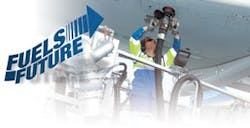The development of alternative fuels is gathering speed — the interest being driven by environmental and cost concerns.
For aircraft jet engines wide scale deployment is still some way off. Any new fuel would have to meet a number of criteria, making research a delicate balancing act. In addition to the obvious need for reducing carbon dioxide emissions (CO2), it would help to limit overall fuel dependency and price as well as to become compatible with existing infrastructure. In some cases, this not only precludes redesigns of jet engines but also storage and distribution methods at the airport.
Francis Couillard, CFM, international general manager of environmental affairs, also identifies the need to meet stringent characteristics such as thermostability and heating values. “This would affect the size of the tank,” he says. “For example hydrogen would need a tank four times as large as kerosene.”
Most research is centred on the Fischer-Tropsch (FT) process, a technology dating from the World War II when Germany realized fuel shortages could become crucial. FT effectively produces a synthetic crude oil from a natural resource such as coal to which conventional refining processes can then be applied.
The benefits of FT include compatibility with current hardware and distribution methods and a relatively abundant supply of raw material. However, Couillard says environmentally-speaking there is no interest in producing fuel from coal because the process still relies on a natural resource, generating greenhouse emissions and causing enviromental damage.
“The same reasons limit gas usage,” he says. “It means the most efficient way forward is biomass, which could be wood, plants or organic residues. Biomass or BTL (Biomass to Liquid) has the potential to reduce CO2 emissions by up to 80 percent.”
Unfortunately, there is no industrialization of biomass as yet and the matter is largely out of engine manufacturers’ hands, involving as it does the fuel companies, State authorities and all other stakeholders.
“There is a lot to demonstrate and validate,” says Couillard. “Substantiation is a long process and it needs a lot more work worldwide.”
Only a handful of companies have commercialized their FT technology. Sasol in South Africa is one example. The company has been producing semi-synthetic fuels (50 percent normal fuel and 50 percent FT fuel) for the aviation industry since 1999, spurred on by shortages in Johannesburg.
Certification for a synthetic jet fuel is nevertheless drawing close. Pratt&Whitney, General Electric and Rolls Royce as well as industry partners such as Honeywell are in the final stages of obtaining approval with tests concluding in three key areas: endurance, ignition and emissions.
CFM mother companies’ Snecma (SAFRAN Group) and General Electric, are also involved in the development of alternative aviation fuels. Snecma is currently working with laboratories and universities worldwide and has helped define specifications of future bio fuels in a European context. A SAFRAN group company has also performed some tests of a gas turbine using a synthetic fuel.
Meanwhile, the first BTL plant should come online in late 2007, a partnership between Shell and CHOREN Industries in Germany. This will use a wood chips base to make the synthetic fuel.
Transforming ground ops
While widespread biofuel for jet engines is a few years away, work on so-called ‘first generation’ fuels such as bioethanol promise much for conventional engines.
The ground support fleet could be transformed — and may well need to be. The US Environmental Protection Agency and Federal Aviation Administration both have airport emission reduction programs in place while environmental concern remains a hot topic in Europe.
Bioethanol uses ethanol derived from crops (specifically the starch or sugar abundant in a number of food crop varieties), which could offer both economic and environmental benefits. It can combine with gasoline in any concentration and although capabilities vary, around 10 percent bioethanol will work without undue effect on current engines. The ongoing research will likely raise that figure considerably.
Unfortunately, bioethanol doesn’t yet have the same fuel economy as conventional gasoline, especially at higher concentrations. It’s reported that 85 percent ethanol mixes can reduce fuel economy by 25 percent compared to conventional fuel. At lower concentrations, CO2 emissions are also less affected.
Shell reports it is working with Canadian concern, Iogen corporation, on an ethanol derived from straw — cellulose ethanol. A demonstration plant for the fuel opened in 2004 and commercial production is scheduled for 2009. This biofuel can be used as a blend in conventional vehicles and an economic study in Germany showed it should be cost competitive.
Then there is biodiesel — a blend of diesel and bio-esters (a chemical interaction between vegetable oil and an alcohol). The extent to which this can be used on unmodified engines is still in debate and as a result engine warranties extend from 5 to 30 biodiesel mixes. Fuel specifications in Europe currently allow 5 percent blends but some manufacturers claim this can be safely improved upon.
Biodiesel is more expensive than the normal variety although as with all biofuels this should change once economies of scale come into play.
Also as with other biofuels, lower engine wear and reduced emissions are an added bonus. Biofuel usage would mean less ‘coking’ and thus a cleaner engine. And in general, the new fuels are chemically compatible with all fuel system materials, such as seals and joints and make use of existing distribution systems.
Electric Shock
Nevertheless, at ground level, electric and Compressed Natural Gas (CNG) vehicles still hold sway in terms of alternative fuel. Swissport, for example, is utilizing electric equipment at several locations, a strategy which, George Hogan, senior vice president of ground handling sales in the Americas reports has worked well.
Hogan says electric vehicle usage has not increased substantially but many airports are moving in this direction with common support infrastructure. One problem is the cost of a unit. “This is based on the higher initial cost plus a need to install chargers/electric, which do not exist at most US airports currently,” says Hogan. ”Also, while units are good for short distance towing at the terminal they do not do well long distance or in snow conditions.”
Many airports around the world are improving infrastructure to handle electric ground fleets but as with biofuels, widespread acceptance has yet to catch on. Manchester Airport in the UK, for example, has a comprehensive environmental program yet reports only that a fleet of new low-emission airside buses have been purchased and trials undertaken of just two Liquefied Petroleum Gas (LPG) vehicles as well as a single electric one.
LPG is a mixture of hydrocarbon gases and, as with CNG, is used by a small percentage of ground support vehicles. CNG is a gasoline substitute made by compressing methane. Both have their advantages environmentally although safety issues have been raised.
It seems that while work continues on alternative fuels, it is only when they become commercially abundant that a true market assessment can be made. But the criteria that any fuel has to meet are exacting, not least of which is the business demands of price and availability.







